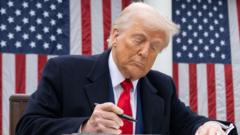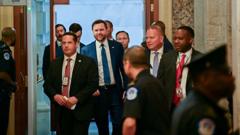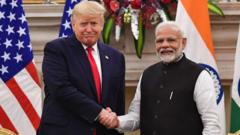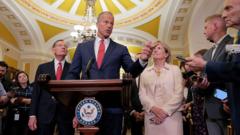Donald Trump has opted for a 90-day freeze on new tariffs to facilitate negotiations, reflecting both market pressures and ongoing international trade challenges.
Trump Pauses Tariffs Amid Market Turmoil and Trade Tensions

Trump Pauses Tariffs Amid Market Turmoil and Trade Tensions
The U.S. President's tariff strategy shifts as stock markets react positively to a temporary halt in proposed increases.
Trump's recent announcement of a temporary suspension on proposed tariffs has brought a moment of relief amid growing global trade tensions. After a week of assertions from his administration about a firm commitment to new "reciprocal" tariffs, the U.S. President has now opted for a 90-day pause. This decision comes as financial markets experienced volatility, with bond yields dropping and public sentiment increasingly critical of his administration's direction.
Initially, Trump's aides dismissed reports of a potential pause. However, the administration has pivoted, claiming that the pause was part of a larger strategic plan to navigate negotiations with over 75 countries. Treasury Secretary Scott Bessent noted after the announcement that this shift was intended to ease concerns raised by investors and the public, indicating a more conciliatory approach to trade relations.
Key to this development was the President's acknowledgment of the unsettled markets, where he remarked the situation had become "pretty glum," suggesting anxiety among investors could be influencing his tariff strategy. Meanwhile, trade adviser Peter Navarro supported the President's decision, stating it exemplified Trump’s ability to negotiate effectively.
In contrast, opposition leaders like Senate Minority Leader Chuck Schumer have criticized the administration's unpredictability, arguing that Trump's approach leads to chaos rather than coherent policy. Schumer argues that this recent backtrack signifies a retreat from hardline stances.
Amid these discussions, questions remain regarding the specifics of the tariff suspension, particularly whether it affects the EU and other trading partners like Mexico and Canada. This uncertainty has left allies navigating a complex landscape of U.S. trade policy.
As the global economy contends with long-standing trade conflicts, especially with China, this temporary relief may not signify a longer-term solution. The increased tariffs against China, set as high as 125%, suggest that while some tensions ease, others may intensify.
Ultimately, as the U.S. embarks on this diplomatic balancing act, the consequences of the administration's decisions will reverberate beyond its borders. In 90 days, the strategic pause may either smooth out the rough edges of the trade landscape or reignite the volatility that has recently characterized U.S. economic relations.
Initially, Trump's aides dismissed reports of a potential pause. However, the administration has pivoted, claiming that the pause was part of a larger strategic plan to navigate negotiations with over 75 countries. Treasury Secretary Scott Bessent noted after the announcement that this shift was intended to ease concerns raised by investors and the public, indicating a more conciliatory approach to trade relations.
Key to this development was the President's acknowledgment of the unsettled markets, where he remarked the situation had become "pretty glum," suggesting anxiety among investors could be influencing his tariff strategy. Meanwhile, trade adviser Peter Navarro supported the President's decision, stating it exemplified Trump’s ability to negotiate effectively.
In contrast, opposition leaders like Senate Minority Leader Chuck Schumer have criticized the administration's unpredictability, arguing that Trump's approach leads to chaos rather than coherent policy. Schumer argues that this recent backtrack signifies a retreat from hardline stances.
Amid these discussions, questions remain regarding the specifics of the tariff suspension, particularly whether it affects the EU and other trading partners like Mexico and Canada. This uncertainty has left allies navigating a complex landscape of U.S. trade policy.
As the global economy contends with long-standing trade conflicts, especially with China, this temporary relief may not signify a longer-term solution. The increased tariffs against China, set as high as 125%, suggest that while some tensions ease, others may intensify.
Ultimately, as the U.S. embarks on this diplomatic balancing act, the consequences of the administration's decisions will reverberate beyond its borders. In 90 days, the strategic pause may either smooth out the rough edges of the trade landscape or reignite the volatility that has recently characterized U.S. economic relations.





















